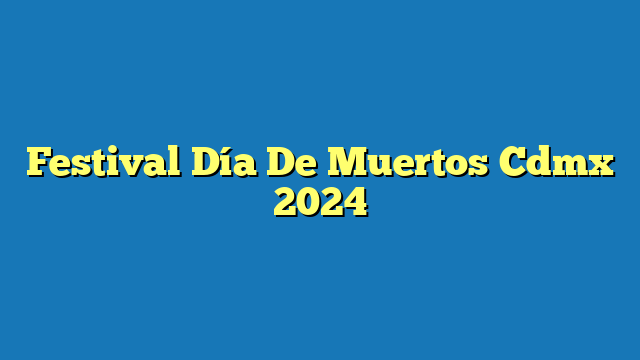## Día de Muertos in Mexico City: A Journey Through Traditions and Symbolism
**Introduction:**
Día de Muertos (Day of the Dead) is one of the most iconic and deeply rooted traditions in Mexico. Celebrated annually from October 31st to November 2nd, it is a time when families come together to honor and remember their deceased loved ones. Mexico City, the bustling capital, embraces this festival with vibrant colors, elaborate decorations, and a myriad of cultural events.
**History and Significance:**
Día de Muertos has pre-Hispanic origins, dating back to the ancient Aztec and Nahuatl civilizations. It was believed that during this time, the boundaries between the world of the living and the dead became blurred, allowing the souls of the departed to return to their families. This belief persists today, and many Mexicans view Día de Muertos as an opportunity to reconnect with their ancestors and celebrate their lives.
**Altars and Offerings:**
One of the central aspects of Día de Muertos is the creation of ofrendas (altars) dedicated to the deceased. These altars are elaborately decorated with colorful marigolds, candles, incense, sugar skulls, food, and personal belongings of the departed. Each of these elements holds symbolic meaning and serves a specific purpose in guiding the spirits of the dead back to their families.
**Marigolds (Cempasúchil):**
Marigolds are the traditional flower of Día de Muertos. Their vibrant colors are believed to attract the souls of the dead and guide them along the path to their altars.
**Candles:**
Candles represent life and hope. They are kept lit throughout the festival to illuminate the altars and help guide the spirits.
**Incense:**
Incense creates a fragrant atmosphere that is believed to purify the space and aid in communication with the dead.
**Sugar Skulls (Calaveras de Azúcar):**
Sugar skulls are a playful and iconic symbol of Día de Muertos. They are decorated with intricate designs and often represent the deceased person.
**Food and Drink:**
Food and drink are an essential part of the ofrendas. The deceased’s favorite dishes and beverages are placed on the altars, believed to nourish and comfort their spirits.
**Traditional Dishes:**
Some traditional dishes served on Día de Muertos include:
* **Pan de Muerto (Bread of the Dead):** A sweet bread shaped like a skull or a bun adorned with bone-like designs.
* **Calabaza en Tacha (Candied Pumpkin):** A sweet and spicy dish made from pumpkin, brown sugar, and cinnamon.
* **Mole Poblano:** A complex and flavorful sauce typically served with meat or vegetables.
**Cultural Events:**
Mexico City hosts a variety of cultural events during Día de Muertos, providing opportunities for locals and tourists alike to experience the festival’s unique atmosphere.
**Mega Procesión de Catrinas (Parade of Catrinas):**
This colorful parade features elaborate costumes and makeup inspired by the iconic Catrina figure, a female skeleton adorned with a large hat.
**Festival de Ofrendas y Arreglos Florales (Festival of Offerings and Floral Arrangements):**
Held at the Zócalo, Mexico City’s main square, this festival showcases traditional and contemporary altars created by artists and community groups.
**Desfile y Concurso de Alebrijes (Alebrije Parade and Contest):**
Alebrijes are fantastical creatures made from papier-mâché and painted in vibrant colors. This parade showcases the artistry and creativity of Mexican artisans.
**Museums and Exhibitions:**
Many museums in Mexico City offer exhibitions and workshops related to Día de Muertos, providing insights into the festival’s history, symbolism, and artistic expressions.
**Visiting Cemeteries:**
On the evening of November 2nd, many families visit the cemeteries where their loved ones are buried. They decorate the graves with flowers, candles, and personal items, and spend the night in vigil, sharing stories and prayers.
**Conclusion:**
Día de Muertos in Mexico City is a vibrant and deeply moving festival that celebrates the enduring bond between the living and the dead. Through its elaborate altars, traditional dishes, and cultural events, it provides a unique opportunity to delve into Mexican history, explore pre-Hispanic beliefs, and honor the memory of those who have passed on.



